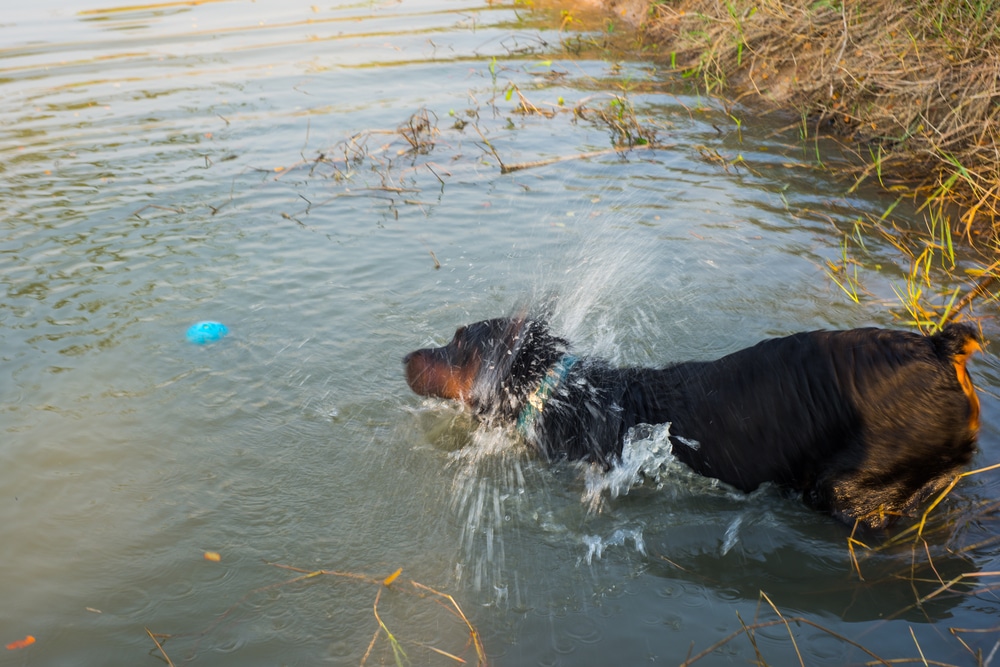While many people assume that Rottweilers are natural swimmers, some may be reluctant to doggy paddle in the water. Like any dog, training and precautions are necessary for water activities involving Rotties.
In this article, we will explore the topic of Rottweilers and water in depth. We will discuss the swimming ability of Rottweilers, as well as the training techniques that can help your furry friend become a confident swimmer.
We will also cover important health considerations that owners should keep in mind, as well as tips for using positive reinforcement to encourage good behavior in and around the water.
Additionally, we will provide information on water safety measures that every owner of many Rottweilers should take to keep their dogs safe during swimming lessons. Read on to learn more!
Key Takeaways
- Rottweilers may need training and precautions for water activities, and gradual exposure and positive reinforcement can help them learn to swim.
- Dogs should never be forced to swim, and their comfort level with water should be respected.
- Pre-existing medical conditions, such as hip dysplasia, should be considered before introducing dogs to swimming, but swimming can be a low-impact exercise that can help improve muscle strength and mobility in dogs with hip dysplasia.
- Appropriate measures should be taken to ensure the safety of dogs when engaging in water activities, such as using life jackets and leashes, and alternative water activities can be enjoyed by Rottweilers and their owners.
Swimming Ability
Rottweilers have a muscular build that is not ideal for swimming in the pool. However, with proper training and support, these dogs can learn to swim and enjoy water exercises while wearing a life vest.
It is important to note that not all Rottweilers are natural swimmers. Some dogs may need more time and patience to become comfortable in the pool.
Swimming challenges for Rottweilers include their weight, which can make it difficult for them to stay afloat, and their short legs, which can make it challenging for them to paddle. To ensure their safety, it is recommended to provide them with a life vest while swimming.
To overcome these challenges, gradual exposure and positive reinforcement can be used to help Rottweilers learn to swim. It is also important to provide them with support, such as a life jacket or a leash, to ensure their safety in water.
With patience and dedication, Rottweilers can become confident swimmers in the pool and enjoy water activities with their families, including their dog companions.
How To Train Your Rottweiler To Swim?
Dog owners who have many rottweilers and want to train their Rotties to swim can use positive reinforcement techniques, gradual exposure, and support to increase their comfort level in the pool.
Positive reinforcement can be in the form of treats or praise when the Rottie exhibits desired behavior while swimming in the pool.
Gradual exposure to swimming can involve starting in a pool with shallow water where the Rottie can touch the bottom and gradually moving to deeper water.
As outlined earlier, support can be in the form of a life jacket or leash to ensure the Rottie’s safety while swimming in the pool.
Additionally, some dogs, including Rotties, may have a fear of water and may require patience and consistent training to overcome their fear of swimming.
It is essential to never force a Rottie dog to swim and to respect their comfort level with water.
Overcoming fear of swimming can involve gradually introducing the Rottie to water, starting with just getting their paws wet and gradually moving to deeper water.
Keeping in mind, that teaching your dog new behaviors can happen quickly and easily by utilizing some clever online training options.
The training listed below is what we highly recommend!

Health Considerations
When introducing dogs to swimming, it is important to consider any pre-existing medical conditions that may affect their ability to swim.
This is especially true for Rottweilers, who are prone to hip dysplasia. Hip dysplasia is a condition where the hip joint does not develop properly. This can cause pain and discomfort for the Rottweiler.
It is important to get medical clearance from a veterinarian before beginning any water activities with a Rottweiler. This is especially the case if they have a history of hip dysplasia or other joint problems.
Preventing hip dysplasia in Rottweilers can be done through careful breeding practices and proper nutrition.
However, once a dog has been diagnosed with hip dysplasia, it is important to manage its condition to prevent further damage. Swimming can be a low-impact exercise that can help improve muscle strength and mobility, but it should be approached with caution.
Always use a life jacket and leash for dog safety, and start with short and gentle dog swimming sessions to prevent dog overexertion.
By taking these precautions, Rottweilers can enjoy swimming while also managing their hip dysplasia in dogs.
Positive Reinforcement
Positive reinforcement training has been found to be effective in helping dogs, specifically Rottweilers, overcome their fear of water and learn how to swim. This type of training involves rewarding desired behaviors with treats, praise, or other positive stimuli.
When it comes to swimming, rewards can be given to dogs for simply being near the water, getting in the water, or making progress in swimming.
Reward-based training can help Rottweilers associate water with positive experiences, which can help them overcome their fear of swimming.
It’s important to note that forcing a Rottweiler dog to swim or punishing them for not wanting to swim can be counterproductive and harmful.
Instead, patience, positive reinforcement, and gradual exposure to water can help Rottweiler dogs gain confidence and learn to enjoy swimming.
Water Safety Measures
Appropriate measures should be taken to ensure the safety of dogs when engaging in water activities.
Rottweilers, in particular, may need extra caution due to their muscular build not being ideal for swimming and their prone to hip dysplasia. It is important to always supervise Rottweilers near water and never force them to swim if they are uncomfortable.
In addition to supervision, water safety measures such as life jackets and leashes should be used to ensure Rottweiler safety.
Gradual exposure and support can also help Rottweilers learn to swim and overcome any fear of water. It is important to respect Rottweiler’s comfort level with water and never push them beyond their limits.
By taking these precautions, dogs like Rottweilers can safely enjoy swimming activities with their families.
Alternative Water Activities

One option for engaging in water activities with a Rottweiler dog is to explore alternative options that do not involve swimming.
Beach games such as frisbee, fetch, and tug-of-war can be enjoyed by Rottweilers and their owners. Water toys such as splash balls and floating toys can also provide entertainment for Rottweilers without the need for swimming.
When engaging in alternative water activities with a dog, such as a Rottweiler, it’s important to ensure their safety.
Rottweilers should always be supervised during water play. This includes wearing a dog life jacket if they are not confident swimmers. It’s also important to choose durable and non-toxic water toys for the dog to avoid any harm.
By exploring alternative water activities, Rottweiler owners can still enjoy fun and engaging water play with their furry friends while respecting their comfort level with swimming.
Grooming Tips after Swimming
Grooming a Rottweiler after swimming is important to maintain their coat’s health and cleanliness. Here are some steps you can follow to groom your Rottweiler after swimming:
- Allow the dog to dry: Before you begin grooming, let your Rottweiler dry off naturally. You can provide them with a clean, dry towel to lie on. This will help absorb excess moisture from their coat.
- Brush the coat: Once your Rottweiler’s coat is mostly dry, use a slicker brush or a grooming comb to remove any tangles or mats. Start brushing from the roots and work your way toward the ends of the hair. This will help prevent the hair from tangling further during grooming.
- Check for debris: While brushing, keep an eye out for any debris. This includes twigs, leaves, or grass, that may have gotten stuck in your dog’s coat during swimming. Remove these foreign objects gently to avoid discomfort or pulling.
- Use a high-velocity dryer (optional): If your Rottweiler has a thick coat or if it’s a cold day, you can use a high-velocity dryer on a low setting to help speed up the drying process. Keep the dryer at a safe distance from your dog and continuously move it to prevent overheating or causing discomfort.
- Check ears and clean if necessary: After swimming, water can get trapped in the Rottweiler’s ears. This can increase the risk of ear infections. Gently examine the ears and use a dog-specific ear cleaner to remove any excess moisture or debris. Avoid inserting anything deep into the ear canal. If you notice any signs of infection or discomfort, seek veterinary advice.
Regular grooming sessions after swimming will keep your Rottweiler’s coat healthy, prevent matting, and maintain its overall cleanliness.
Frequently Asked Questions
Are there any specific water activities that Rottweilers excel in?
Rottweilers, a popular breed of dog, are not known for excelling in aquatic competitions or water sports. However, they can enjoy swimming and other water activities with proper training, support, and safety precautions.
Can Rottweilers swim in rough or choppy water conditions?
Rottweilers can swim in rough or choppy water conditions with proper dog training and water safety tips. However, caution is advised due to their muscular build and potential for hip dysplasia. Always supervise Rottweilers near water to ensure their safety.
How often should Rottweilers be groomed to maintain their coat and hygiene?
Regular grooming frequency for Rottweilers is important to maintain their coat and hygiene. It’s recommended to brush their coat weekly and bathe them every 2-3 months to avoid skin irritation. Extra treats and patience can help during grooming sessions.
Are there any common mistakes that owners make when training Rottweilers to swim?
Common mistakes when training Rottweilers to swim include forcing them into water and not providing gradual exposure and support. Proper technique involves positive reinforcement, patience, and supervision, with life jackets and leashes for safety.
Do Rottweilers need any special equipment or gear for swimming?
Rottweilers benefit from using swimming gear such as life jackets and leashes to ensure their safety in water. Caution should be taken to avoid hip dysplasia. Always supervise Rottweilers around water.
Why Aren’t Rottweilers Great Swimmers?
Rottweilers are generally considered good swimmers, as their muscular build and dense coat aid in buoyancy. However, not all Rottweilers excel in swimming. This is due to factors such as their robust body structure, potential lack of water confidence, or individual preference.
While some Rottweilers may face challenges staying afloat or may not enjoy swimming, it’s important to respect their preferences. This includes providing gradual training and exposure to water if desired.
With proper acclimation, many Rottweilers can become competent swimmers. It is crucial to prioritize safety and seek guidance from professionals if needed.


